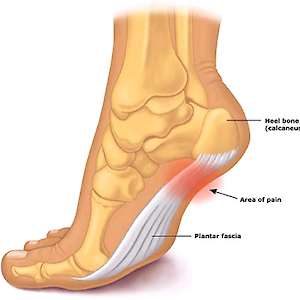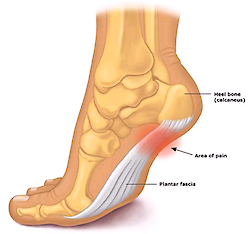What is plantarfasciitis?

Experiencing heel pain? Heel pain is one of the most common foot problems that Blueprint Podiatry will assess and treat in both paediatric podiatry (children) and adults. In Plantar Fasciitis, tearing and inflammation occurs in your plantar fascia, leading to uncomfortable and painful heels. Read more below to understand the symptoms of Plantar Fasciitis and the treatments we have available through our podiatry clinic located in Tuggerah on the Beautiful Central Coast.

Plantar Fascia Anatomy
The plantar facia is a strong band of fibrous connective tissue that lines most of the plantar sole of the foot, just below the skin layer and superficial to the first muscle layers. Its main attachments include the heel and digits of the foot. Furthermore, it can be broken down into three distinct portions based on location, thickness and length. These are the medial, intermediate and lateral bands and you may note that your podiatrist reports this in the diagnosis of your condition. The most affected portion is the proximal medial band.
The plantar fascia’s function is to support the medial longitudinal arch during weight bearing, absorb shock and recycle energy. With the plantar fascia responding to this force/stress, overtime chronic changes can occur and be seen in the tissue. For example, it is well accepted in the medical community, that the plantar fascia on ultrasound assessment is thicker in diagnosed, symptomatic plantar fasciopathy patients compared to asymptomatic individuals.
What is Plantar Fasciopathy or Plantar Fasciitis?
- Plantar fasciopathy can involve micro-tears in the plantar fascia
- Where Plantarfasciitis Involves the inflammation of the plantar fascia
What are the signs and symptoms of Plantarfasciitis/opathy?
You may experience…
- A sharp pain on the bottom on your foot - as if you’ve stepped on a sharp object.
- Heel pain that is often more painful in the morning after your first steps.
- Heel pain after standing for long periods of time or moving the body from a seated position
- Heel pain after exercise. (not necessarily during)
- Occasional mild swelling in the heel
Plantarfasciitis is especially prone to…
- Sudden increases in activity – Sudden increases in activity or standing for long periods, especially if wearing poor footwear increases your chances of developing plantar fasciitis and heel pain.
- Weight factors - You generally have a higher chance of experiencing Plantar Fasciitis if you are overweight. This is due to the increased pressure on the plantar fascia. This would especially be the case if you have a sudden weight gain.
- Age - Yes, unfortunately getting older does mean a higher chance of experiencing plantar fasciitis.
- Poor shoe wear - Wearing unsupportive footwear can over time lead to plantar fasciitis.
- Calf Tightness
Diagnosis
At BLueprint Podiatry, one of our experienced Podiatrists can provide an accurate clinical assessment to diagnose plantar fasciitis. We may, on occasions require an ultrasound to give a professional diagnosis and on rare occasions an MRI.
Treatments
Blueprint Podiatry has a range of treatments available for different levels of plantar fasciitis. Our professional podiatrists will give you an expert diagnosis and a personalised treatment plan so you’re on the road to recovery sooner.
Mechanical Treatments
- Taping/padding
- Plantar, achilles, hamstring stretching.
- Orthotic therapy
- Shoe wear modification
- Offloading boot - Footwear designed to provide pressure redistribution for patients
- Massage
Pharmacological
- Oral anti-inflammatories
- Corticosteroid injection (via a GP)
- PRP injection (via a Sports Doc
Healing Rate
The plantar fascia tissue is not well vascularised. This means, the tissue has relatively slower blood supply compared to other tissues, such as muscle. The plantar fascia tissue generally takes longer to heal, on average around 6-8 weeks for most symptoms to be resolved. The longer the condition has been active, the longer healing time it will require. This is why we encourage patients to book an appointment immediately after they feel signs of heel pain or aches in the feet.